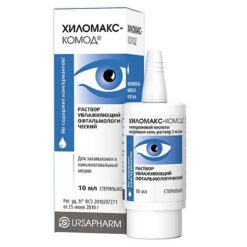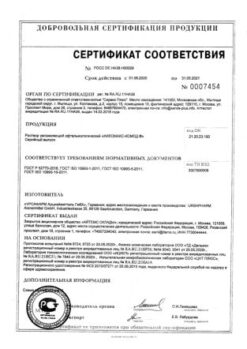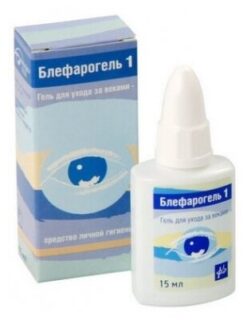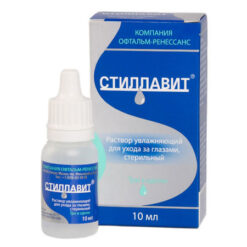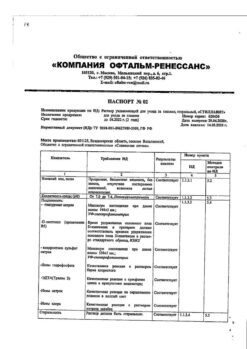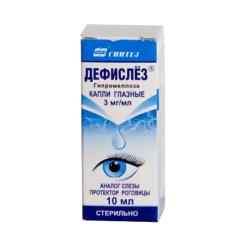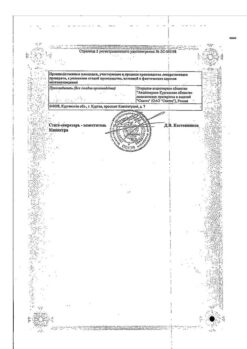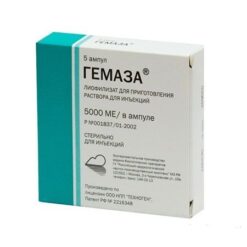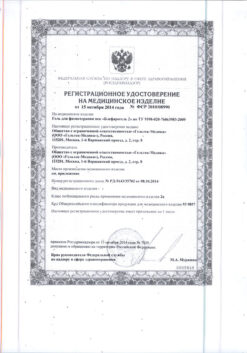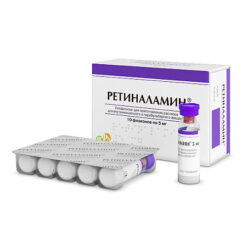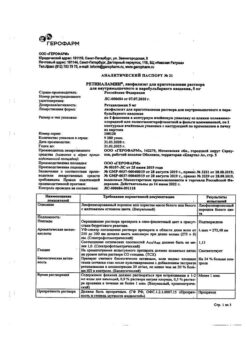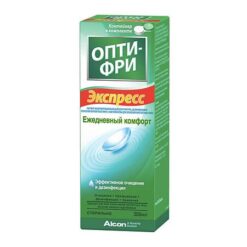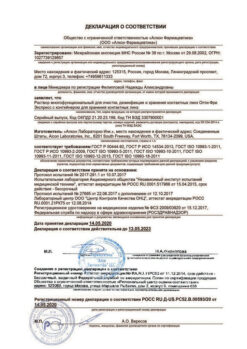No products in the cart.
Stelfrin, eye drops 2.5% 10 ml
€20.18 €17.49
Out of stock
(E-mail when Stock is available)
Description
Pharmacotherapeutic group: Alpha-adrenomimetic
ATC code: S01FB01
Pharmacodynamics:
Phenylephrine is a sympathomimetic. It has pronounced alpha-adrenergic activity.
When used topically in ophthalmology, it causes dilation of the pupil improves the outflow of intraocular fluid and narrows the conjunctival vessels.
Phenylephrine has a strong stimulatory effect on the postsynaptic alpha-adrenoreceptors and has very little effect on the beta-adrenoreceptors of the heart. The drug has a vasoconstrictor effect similar to that of norepinephrine (noradrenaline), while it has almost no chronotropic and ionotropic effect on the heart. The vasopressor effect of phenylephrine is weaker than that of norepinephrine, but it is longer lasting. Causes vasoconstriction 30-90 s after instillation duration is 2-6 h.
After instillation, phenylephrine contracts the dilator of the pupil and the smooth muscles of the conjunctival arterioles, thus causing pupil dilation. Midriasis occurs within 10-60 min after a single instillation. Midriasis persists after instillation of 25% solution for 2 hours. Midriasis caused by phenylephrine is not accompanied by cycloplegia.
Phenylephrine easily penetrates into ocular tissues and reaches maximum concentration in plasma 10-20 min after instillation into eye. Phenylephrine is excreted by the kidneys unchanged (< 20%) or as inactive metabolites.
Indications
Indications
Iridocyclitis (to prevent the occurrence of posterior synechiae and reduce exudation from the iris).
For diagnostic pupil dilation during ophthalmoscopy and other diagnostic procedures necessary to monitor the condition of the posterior segment of the eye.
Conducting a provocative test in patients with a narrow anterior chamber angle profile and suspected angle-closure glaucoma.
Differential diagnosis of superficial and deep injection of the eyeball.
Red eye syndrome (to reduce hyperemia and irritation of the mucous membrane of the eye).
Spasm of accommodation.
Pharmacological effect
Pharmacological effect
Pharmacotherapeutic group: Alpha adrenergic agonist
ATX code: S01FB01
Pharmacodynamics:
Phenylephrine is a sympathomimetic. Has pronounced alpha-adrenergic activity.
When applied topically in ophthalmology, it causes dilation of the pupil, improves the outflow of intraocular fluid and constricts the vessels of the conjunctiva.
Phenylephrine has a pronounced stimulating effect on postsynaptic alpha-adrenergic receptors and has a very weak effect on beta-adrenergic receptors of the heart. The drug has a vasoconstrictor effect similar to the action of norepinephrine (noradrenaline), while it has virtually no chronotropic and ionotropic effects on the heart. The vasopressor effect of phenylephrine is weaker than that of norepinephrine but is longer lasting. Causes vasoconstriction 30-90 s after instillation, duration is 2-6 hours.
After instillation, phenylephrine contracts the pupillary dilator and smooth muscle of the conjunctival arterioles, thereby causing pupillary dilation. Mydriasis occurs within 10-60 minutes after a single instillation. Mydriasis persists after instillation of a 25% solution for 2 hours. Mydriasis caused by phenylephrine is not accompanied by cycloplegia.
Pharmacokinetics:
Phenylephrine easily penetrates into the eye tissue; the maximum plasma concentration is achieved 10-20 minutes after instillation into the eye. Phenylephrine is excreted by the kidneys unchanged (<20%) or in the form of inactive metabolites.
Special instructions
Special instructions
Exceeding the recommended dose of a 25% solution in patients with trauma, diseases of the eye or its appendages in the postoperative period or with reduced tear production may lead to increased absorption of phenylephrine and the development of systemic side effects. The drug does not contain a preservative, which avoids undesirable effects of the preservative on the external tissues of the eye, the conjunctiva and cornea, and also eliminates the risk of developing allergic reactions to the preservative.
Impact on the ability to drive vehicles. Wed and fur.:
After using the drug, due to changes in accommodation and pupil width, visual acuity may decrease, so until it is restored, it is not recommended to drive vehicles or engage in potentially hazardous activities that require increased concentration and speed of psychomotor reactions.
Active ingredient
Active ingredient
Phenylephrine
Composition
Composition
1 ml of the drug contains:
Active ingredient:
Phenylephrine hydrochloride 25.0 mg
Excipients:
Polyethylene glycol 300 19.0 mg
(macro goal 300)
Sodium hyaluronate 2.7 mg
Water for injections up to 1.0 ml.
Pregnancy
Pregnancy
The effect of phenylephrine in pregnant women has not been sufficiently studied; therefore, the drug can be used in this category of patients only if the expected benefit to the mother outweighs the potential risk to the fetus or child. It is unknown whether the drug is excreted in breast milk.
In animals in late pregnancy, phenylephrine caused fetal growth retardation and stimulated early onset of labor.
When prescribed during lactation, breastfeeding is recommended to be stopped for the duration of treatment.
Contraindications
Contraindications
Hypersensitivity to the components of the drug.
Narrow-angle or closed-angle glaucoma.
Old age.
Severe cardiovascular or cerebrovascular diseases.
Arterial hypertension in combination with coronary heart disease, aortic aneurysm, atrioventricular blockade of MP degree, arrhythmia.
Tachycardia.
Impaired tear production.
Prematurity; children under 6 years of age (with spasm of accommodation).
Hyperthyroidism.
Hepatic porphyria.
Congenital deficiency of glucose-6-phosphate dehydrogenase.
Rhinitis.
With caution:
Diabetes mellitus (risk of increased blood pressure associated with impaired autonomic regulation).
Concomitant use with monoamine oxidase inhibitors (including within 21 days after stopping their use).
Sickle cell anemia wearing contact lenses after surgery (decreased healing due to conjunctival hypoxia).
Side Effects
Side Effects
From the side of the organ of vision
Conjunctivitis periorbital edema.
In some cases, patients note a burning sensation at the beginning of use, blurred vision, irritation, a feeling of discomfort in the eye, increased lacrimation, increased intraocular pressure.
Phenylephrine may cause reactive miosis the day after use. Repeated instillations of the drug at this time can lead to less pronounced mydriasis than previously observed. This effect is more common in older patients.
Due to a significant contraction of the muscle dilating the pupil, 30-45 minutes after instillation under the influence of phenylephrine, particles of pigment from the pigment leaf of the iris may be detected in the moisture of the anterior chamber of the eye. Suspension in the chamber fluid must be differentiated from manifestations of anterior uveitis or from the ingress of blood cells into the fluid of the anterior chamber.
Systemic reactions
From the skin and its appendages: contact dermatitis.
From the cardiovascular system: palpitations, tachycardia arrhythmia, increased blood pressure, ventricular arrhythmia, reflex bradycardia, coronary artery occlusion, pulmonary embolism.
Interaction
Interaction
The mydriatic effect of phenylephrine is enhanced when used in combination with topical atropine. Due to increased vasopressor action, tachycardia may develop.
The use of phenylephrine with monoamine oxidase inhibitors and within 21 days after stopping their use should be carried out with caution, as in this case there is the possibility of an uncontrolled rise in blood pressure. The vasopressor effect of α-adrenergic agonists can also be potentiated when used simultaneously with tricyclic antidepressants, propranolol, reserpine, guanethidine, methyldopa, and m-anticholinergics.
Phenylephrine may potentiate the depression of cardiovascular activity during inhalation anesthesia.
Concomitant use with other adrenergic agonists and sympathomimetics may enhance the effect of phenylephrine on the cardiovascular system.
The use of phenylephrine may weaken concomitant antihypertensive therapy and lead to an increase in blood pressure and tachycardia.
Overdose
Overdose
Symptoms: restlessness, nervousness, dizziness, sweating, vomiting, palpitations, weak or shallow breathing.
Treatment: if a systemic effect of phenylephrine occurs, side effects can be stopped by using α-adrenergic blockers, for example, 5-10 mg of phentolamine intravenously. If necessary, you can repeat the injection.
Storage conditions
Storage conditions
At a temperature not exceeding 25 °C.
Keep out of the reach of children.
Shelf life
Shelf life
2 years.
Do not use after the expiration date!
Manufacturer
Manufacturer
Grotex LLC, Russia
Additional information
| Shelf life | 2 years. Do not use after the expiration date! |
|---|---|
| Conditions of storage | At a temperature not exceeding 25 ° C. Store out of the reach of children. |
| Manufacturer | Grotex Ltd, Russia |
| Medication form | eye drops |
| Brand | Grotex Ltd |
Related products
Buy Stelfrin, eye drops 2.5% 10 ml with delivery to USA, UK, Europe and over 120 other countries.


